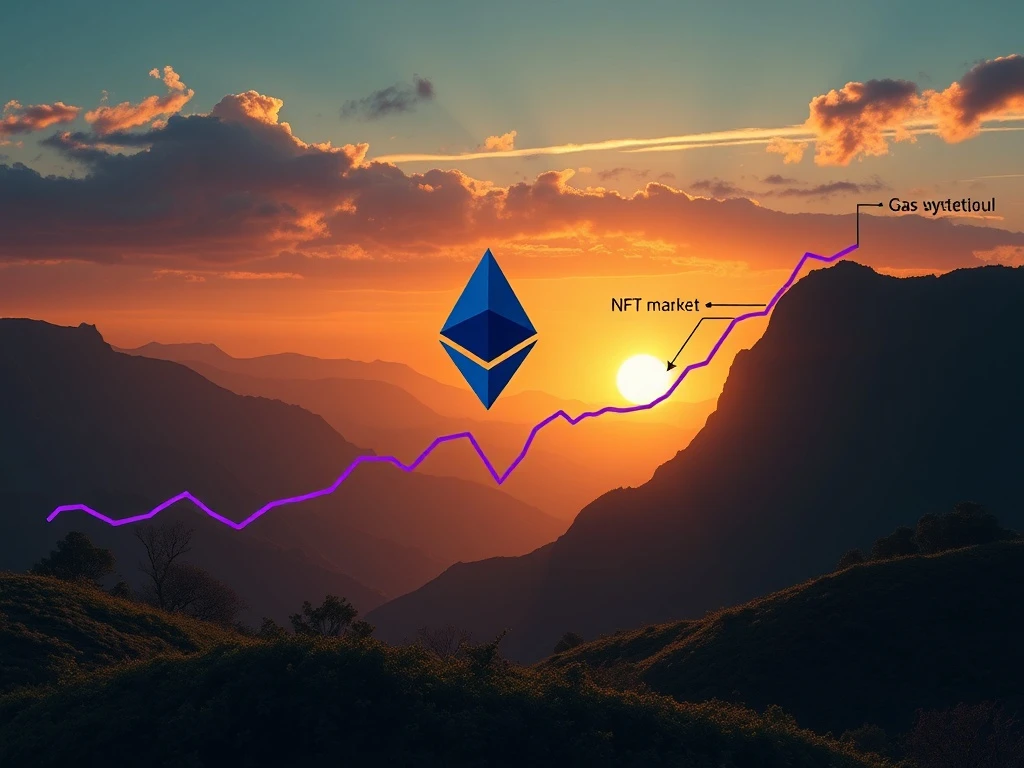Ethereum’s Astonishing Resilience: Record Gas Usage Defies Crypto Downturn as NFT Sector Slumps

In a fascinating turn of events, the cryptocurrency world is witnessing a stark divergence: while the broader market navigates a challenging period, Ethereum gas usage has hit an all-time high. This surge in network activity signals remarkable resilience for the leading smart contract platform, even as the NFT sector grapples with a significant downturn. What does this contrast tell us about the evolving priorities within the crypto ecosystem?
Ethereum Gas Usage: A Beacon of Strength
On July 8, Ethereum’s network saw its gas usage reach an unprecedented peak. This isn’t just a technical detail; it’s a powerful indicator of sustained on-chain activity. Gas usage reflects the computational effort required to execute transactions and smart contract interactions on the network. A record high suggests that despite the prevailing crypto downturn, users and developers are actively engaging with decentralized applications (dApps) and DeFi protocols built on Ethereum.
- High Transaction Volumes: More users are sending transactions, interacting with tokens, and utilizing Ethereum’s core functionalities.
- Smart Contract Interactions: Decentralized finance (DeFi) platforms, gaming dApps, and other complex applications are seeing significant usage.
- Underlying Utility: This surge reinforces Ethereum’s position as critical infrastructure, rather than just a speculative asset.
This sustained activity underscores the network’s foundational role in the decentralized web, proving its utility even when market sentiment is cautious.
The Unsettling NFT Market Slump
While Ethereum’s core network thrives, the non-fungible token (NFT) sector tells a different story. By July 23, NFT prices and trading volumes had plunged over 7%. This NFT market slump reflects renewed investor skepticism towards speculative digital assets, a sharp contrast to the euphoria seen in previous bull runs.
What’s driving this decline?
- Macroeconomic Pressures: Global economic uncertainties, including inflation and interest rate hikes, often lead investors to de-risk and move away from highly speculative assets.
- Shifting Investor Focus: There’s a noticeable shift towards utility-driven blockchain use cases rather than purely collectible or artistic digital goods.
- Market Saturation: The sheer volume of new NFT projects may have diluted demand, making it harder for projects without strong utility or community to sustain value.
While isolated instances of success, like the CryptoBatz NFTs seeing a 400% price spike due to celebrity interest, do occur, they are largely outliers that fail to counteract the sector’s overall downward trend. This highlights the growing maturity of the crypto market, where fundamental value and utility are increasingly prioritized over hype.
Navigating the Crypto Downturn: Ethereum’s Unique Position
The broader crypto downturn has tested the mettle of many digital assets. Bitcoin, while still dominant, has faced its own challenges. However, Ethereum’s performance, particularly its gas usage, suggests a unique resilience. This is partly due to its ongoing evolution.
Ethereum’s transition to a proof-of-stake (PoS) consensus mechanism, known as The Merge, has significantly reduced its energy consumption while enhancing security. This move has not only addressed environmental concerns but also positioned Ethereum as a more sustainable and scalable blockchain for the future. The ability to adapt and improve its core infrastructure has been crucial in maintaining its relevance and appeal even in tough market conditions.
Unpacking Ethereum’s Resilience: Beyond Gas Usage
The story of Ethereum resilience extends beyond just gas usage. It encompasses its robust developer ecosystem, the sheer breadth of dApps built on it, and its continuous technological advancements. While some competitors, like Tron, have shown impressive growth in fee revenue, sometimes even exceeding Ethereum’s in certain metrics (especially in stablecoin and gaming sectors due to lower costs), Ethereum maintains its lead in terms of total value locked (TVL) in DeFi and overall developer activity.
Ethereum’s network benefits from a powerful network effect. The more developers build on it, the more users join, and the more valuable the network becomes. This virtuous cycle creates a strong moat, making it difficult for newer blockchains to unseat its dominance, even if they offer competitive advantages in specific niches.
The Growing Wave of Institutional Ethereum Interest
Perhaps one of the most compelling signs of confidence in Ethereum’s long-term viability is the burgeoning institutional Ethereum interest. Recent reports indicate a dramatic increase in institutional holdings:
- Goldman Sachs’ Ethereum ETF holdings reportedly surged by 2,000% to $476 million.
- Bitcoin ETF investments from institutional players also doubled to $1.5 billion.
These significant investments from major financial players like Goldman Sachs signal a growing belief in Ethereum’s potential as a legitimate asset class. Institutional adoption often brings greater liquidity, stability, and mainstream acceptance to the crypto market. Their focus on assets with strong fundamentals and clear use cases further validates Ethereum’s strategic importance.
Conclusion: A Maturing Market Landscape
The current market dynamics paint a clear picture of a maturing crypto landscape. The divergence in performance between infrastructure-focused blockchains like Ethereum and speculative assets like NFTs highlights a shift in investor priorities. While Ethereum’s technical upgrades, sustained network activity, and growing institutional adoption provide a crucial counterbalance to market volatility, the NFT sector’s struggles reflect the inherent challenges in monetizing non-essential digital goods in a bear market.
As competition intensifies and regulatory uncertainties persist, the ability of crypto projects to balance groundbreaking innovation with practical, utility-driven applications will ultimately determine their long-term endurance. Ethereum, with its demonstrated resilience and foundational role, appears well-positioned to navigate these evolving market conditions and continue its pivotal journey in the decentralized future.
Frequently Asked Questions (FAQs)
Q1: What does Ethereum’s record gas usage signify?
Ethereum’s record gas usage indicates a high level of sustained on-chain activity, including numerous transactions and interactions with smart contracts. It signals that despite a broader crypto downturn, users are actively engaging with decentralized applications (dApps) and DeFi protocols on the Ethereum network, reinforcing its utility and foundational role.
Q2: Why is the NFT market experiencing a slump?
The NFT market slump is attributed to several factors, including macroeconomic pressures (like inflation and interest rate hikes), a shift in investor focus towards utility-driven blockchain use cases, and potential market saturation. Investors are becoming more cautious and moving away from highly speculative digital assets.
Q3: How does institutional interest impact Ethereum?
Growing institutional interest, exemplified by firms like Goldman Sachs increasing their Ethereum ETF holdings, brings significant benefits. It signals increased confidence in Ethereum’s long-term viability, can lead to greater market liquidity and stability, and contributes to the mainstream acceptance of Ethereum as a legitimate asset class.
Q4: Has Ethereum’s Proof-of-Stake transition played a role in its resilience?
Yes, Ethereum’s transition to a Proof-of-Stake (PoS) consensus mechanism (The Merge) has significantly contributed to its resilience. It has drastically reduced energy consumption, making the network more sustainable, and enhanced its security. This upgrade makes Ethereum more appealing to environmentally conscious investors and strengthens its fundamental technology.
Q5: How does Ethereum’s performance compare to other blockchains during this period?
While Ethereum shows strong resilience with record gas usage, some other networks like Tron have also seen growth, particularly in stablecoin and gaming sectors due to lower transaction costs. However, Ethereum maintains its lead in terms of total value locked in DeFi and overall developer activity, indicating its continued dominance as a primary blockchain infrastructure.










